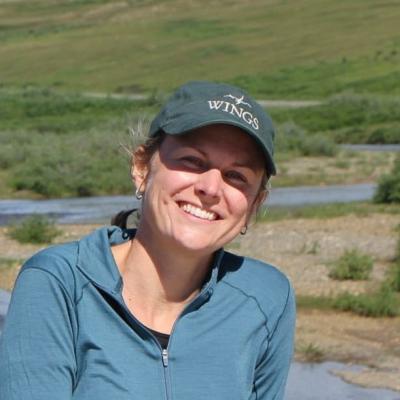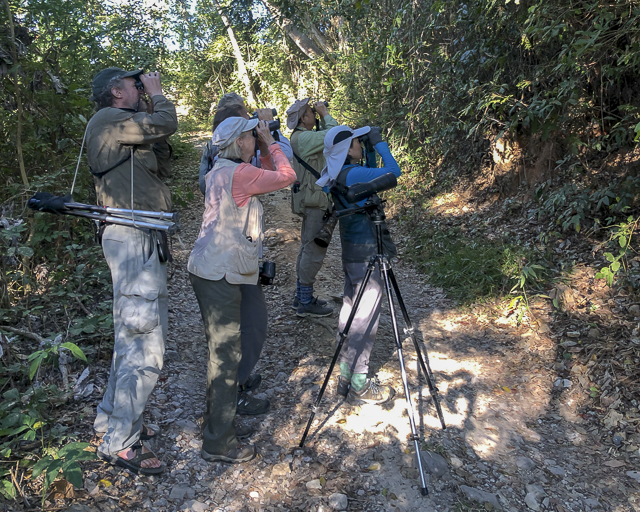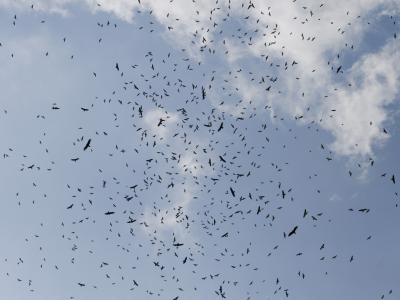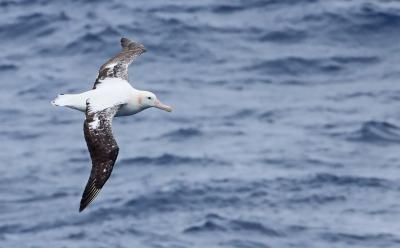Mexico: San Blas
Mangroves and Forests
-
Feb 9-17, 2026
Steve Howell
Tour Price to be Determined
Tour Price to be Determined
Not far from the U.S. yet in the midst of a rich and decidedly tropical avifauna, the small coastal fishing town of San Blas, Nayarit, has long been famous among birdwatchers. From our base in town we’ll explore the nearby palm and thorn forests, oak woods, coffee plantations, mangroves, freshwater marshes, beaches, and coastal lagoons. These habitats host birds ranging from Blue-footed Booby and Wilson’s Plover to Russet-crowned Motmot, Fan-tailed Warbler, and the little-known Mexican Woodnymph. Other highlights among the many possibilities, including 30+ Mexican endemics, are Bare-throated Tiger-Heron, Rufous-necked Wood-Rail, Mexican Parrotlet, Cinnamon Hummingbird, Black-throated Magpie-Jay, San Blas and Purplish-backed Jays, and Golden Vireo. This short tour, based at an exceptional hotel with a fine restaurant, a swimming pool, and a staff that accommodates birdwatchers, provides an opportunity for relaxation as well as an excellent introduction to birding in Mexico.
Day 1: The trip begins at 7:00 pm in Puerto Vallarta. Night in Puerto Vallarta.
Honestly, I was along for the ride and didn’t give the trip much thought beforehand… BUT I pretty quickly rediscovered the joy of birdwatching, hiking in parts unknown, and hanging out with new friends and an amazingly talented leader. - Leslie H.
Days 2-8: We’ll depart early for birding near Puerto Vallarta, where a good variety of species should include the endemic San Blas Jay which, ironically, isn’t in San Blas! After an early lunch at the hotel we’ll drive north through the humid coastal hills to San Blas, our base for the coming week. We should find around 250 species within a few miles of town as we travel from the plantations and scrub around San Blas to palm forest near Singayta, shady coffee plantations and pine-oak forest, and the beach and lagoons at Matanchen.
Characteristic landbirds around San Blas include Citreoline Trogon, Golden-cheeked Woodpecker, Sinaloa Crow, Happy Wren, Rufous-backed Thrush, and Yellow-winged (Mexican) Cacique, and we’ll always be on the lookout for surprises such as Black-and-white Hawk-Eagle or Cassin’s Sparrow, which seem to pop up regularly. The area also holds a wealth of wintering migrants from North America including Black-capped Vireo and Painted Bunting. Certainly one of the highlights of a birding trip to San Blas is an evening boat trip winding through the mangroves, famous for roosting Boat-billed Herons and for Northern Potoos, which come out to hawk for insects at dusk.
We’ll also make a day trip to a nearby mountain with pine-oak forest which offers a cooler climate and birds including White-eared, Berylline, and Bumblebee Hummingbirds, Red-faced, Hermit, and Rufous-capped Warblers, Painted and Slate-throated Whitestarts (aka Redstarts), Tufted Flycatcher, and perhaps Red-headed Tanager and White-striped Woodcreeper.
Early starts are important to make the most of the rich birdlife, and optional after-lunch siestas are recommended before bird activity picks up again in late afternoon. A good beach is close to the hotel and the area is famous for its excellent mariscos (seafood) and green-flash sunsets. Nights in San Blas.
Day 9: We’ll drive this morning to Puerto Vallarta, arriving at the airport about noon when the tour concludes.
Note: The information presented below has been extracted from our formal General Information for this tour. It covers topics we feel potential registrants may wish to consider before booking space. The complete General Information for this tour will be sent to all tour registrants and of course supplemental information, if needed, is available from the WINGS office.
ENTERING MEXICO: Mexico now requires a valid passport for entry by U.S. citizens. Tourist cards are no longer required, but customs forms are and should be distributed by your entering airlines. Citizens of other countries may need a visa and should check with the nearest Mexican embassy or consulate.
COUNTRY INFORMATION: You can review the U.S. Department of State Country Specific Travel Information here: https://travel.state.gov/content/travel.html and the CIA World Factbook here: https://www.cia.gov/the-world-factbook/. Review foreign travel advice from the UK government here: https://www.gov.uk/foreign-travel-advice and travel advice and advisories from the Government of Canada here: https://travel.gc.ca/travelling/advisories.
PACE OF THE TOUR: As with all tours in the tropics, we’ll try to be in the field around dawn which, given the configuration of planets, sun, and local time zones, means 6:30 a.m. Most birding sites are within 5 minutes’ walk to 30 minutes’ drive of our hotel in San Blas, which puts on great buffet breakfasts before we leave in the mornings. The first morning at Puerto Vallarta we’ll be in the field for a few hours before breakfast (coffee should be available at the hotel). We’ll return to fill up with a hot brunch before packing the van and heading to San Blas. Lunches will be at the hotel restaurant except for one or two picnic lunches. Dinners will be at the hotel which, in the opinion of many, has some of the best food in all of Mexico.
Birding in and around San Blas we’ll be on trails and roads that are mostly flat and present no particular problem, but be aware that tropical birding often requires standing around a fair bit, which can be as tiring as walking; some people find a light portable stool helpful in such cases. One uphill cobbled road is steep in places though, and we take our time and rest when necessary. On a couple of days we have boat trips on the river for up to 5 hours - by now we’ve figured out where to make bathroom stops! Most days we’re in the field for 5-6 hours (birding, walking slowly, resting when necessary) before returning for lunch, a siesta and/or swim in the pool, and an afternoon birding near town. The exception is an all-day trip to some pine-oak forest at 5000 feet elevation on Cerro de San Juan, about an hour’s drive from San Blas, and we’ll be back in time to rest and shower before dinner.
HEALTH: The Centers for Disease Control and Prevention (CDC) recommends that all travelers be up to date on routine vaccinations. These include measles-mumps-rubella (MMR) vaccine, diphtheria-tetanus-pertussis vaccine, varicella (chickenpox) vaccine, polio vaccine, and your yearly flu shot.
They further recommend that most travelers have protection against Hepatitis A and Typhoid.
Please contact your doctor well in advance of your tour’s departure as some medications must be initiated weeks before the period of possible exposure.
The most current information about travelers’ health recommendations can be found on the CDC’s Travel Health website here: https://wwwnc.cdc.gov/travel/destinations/list
Malaria: It is the opinion of the Centers for Disease Control that travelers to the Mexican state of Nayarit (where San Blas is) are at risk for malaria. You should consult further with your doctor about the CDC’s recommendation and what action you should take. Note that in the opinion of our hotel owners, there have been no recent cases of malaria in San Blas.
Miscellaneous: We have found that careful eating habits are important in order to avoid most intestinal problems. In most of Mexico it is unwise to drink untreated water, although bottled water and soft drinks are reliable and widely available.
Insects (no-see-ums and mosquitos) can be numerous on some days, at least for an hour or so early and late in the day. We recommend using insect repellents with a high concentration of DEET. Newer products containing tick- and chigger-repelling chemicals are particularly effective.
Smoking: Smoking and vaping are prohibited in the vehicles or when the group is gathered for meals, checklists, etc. If you are sharing a room with a non-smoker, please do not smoke in the room. If you smoke in the field, we ask that you do so well away and downwind from the group.
If any lodge, accommodation or location where the group is staying or is gathered has a more restrictive smoking policy than WINGS’ policy, the more restrictive policy will prevail.
CLIMATE: San Blas is in the tropical lowlands, so the climate is usually warm to hot (70s to 80s) and variably humid, but early and late in the day it can be cooler on boat trips (50s and humid) This is the dry season though, so rain is unusual - but it always best to bring a small travel umbrella or poncho, just in case. The early morning at Cerro de San Juan can be cool enough (40s, very rarely lower) for a jacket and light gloves but things soon become warm to hot (60s to 70s).
ACCOMMODATIONS: The first night we stay in a resort hotel by the beach in Puerto Vallarta which has all the usual tourist facilities, but not an elevator. In San Blas we stay at the family-run Garza Canela Hotel, which has many years catering to birding groups and has a justly famous restaurant, friendly and helpful staff, an open air pool, and gift shop. The rooms are spacious and very comfortable with air conditioning and a ceiling fan, television and Wi-Fi, but no phone. Phone calls can be made and faxes sent from the front office during business hours. The beach and town square are about 10 minutes’ walk in opposite directions from the hotel.
2025 Narrative
As always, our week in San Blas was a wonderful winter getaway to birds and warm weather, and in a relatively relaxed way based at a very comfortable hotel with excellent food and hospitality – plus a great group of folks to be with, away from the madness of the so-called ‘developed’ world. Highlights ranged from endearing Spotted Wrens to colorful Spotted Rails; from enigmatic Masked Ducks to quirky Masked Tityras; from handsome Elegant Quail to sleek Elegant Terns; from cryptic potoos and stunning orioles to bizarre Boat-billed Herons and a bathing parade of warblers; from flashy endemic jays and majestic Military Macaws to large crocodiles and colorful butterflies; from record numbers of kingfishers and a good showing of plovers to the sounds of the forest and the surf. The impressive diversity of habitats, from mangrove tunnel boat rides and pine-oak forest to quiet sandy beaches and shade-coffee plantations, produced around 250 species in a week of birding, but all too soon it was over.
Everyone arrived safely, and even in time the first afternoon for a little ‘pre-tour’ birding near the hotel, and an early appreciation for just how birdy this part of the world is in winter, with species including the very attractive Golden-cheeked Woodpecker, an unconcerned Ferruginous Pygmy Owl, and a surprise Grayson’s [Rufous-backed] Thrush, seemingly the first state record for Jalisco!
After the intro meeting and dinner we all retired for a good sleep. The next day was a travel day, but with some early morning birding near Puerto Vallarta before making the drive to San Blas. Morning highlights included San Blas Jays, a confiding adult Common Black Hawk, low-down Magnificent Frigatebirds, and great looks at Snowy and Wilson’s Plovers, two sadly declining species. After brunch we headed to San Blas, with stops for some tasty local fruit and a river mouth with sundry waterbirds. Checked into our home for the next week, we headed to the fort overlooking town for some birding, a cold drink, history, and even a little poetry before a nice sunset over the Pacific. A scope-filling Russet-crowned Motmot, a shady brush pile that yielded great views of Happy Wren and MacGillivray’s Warbler, and stunning Black-throated Magpie-Jays were all wonderful—but it was a spectacular Collared Forest Falcon that stole the show. Not too bad for a travel day!
Our first morning in San Blas we simply walked from our rooms to areas around town. The great variety of birds began with Lineated Woodpecker and Russet-crowned Motmot before we had walked even a block (!), followed in short order by Purple Gallinules, Yellow-breasted Chats, and a very obliging Citreoline Trogon. The bird-filled morning continued with Painted Buntings, Purplish-backed Jays, soaring Great Black Hawks, overlookable Ruddy-breasted Seedeaters, striking Stripe-headed Sparrows, and vagrant Yellow-throated Warbler and Rock Wren! After lunch and a siesta we took an other-worldly boat ride along the Río San Cristobal and then through mangrove tunnels (quite an experience at night) to La Tovara, staying out in search of the bizarre Northern Potoo—of which we had superb views. Birding from a boat is fun and relaxing, and the many highlights included good views of Rufous-necked Wood-Rail, Ringed Kingfisher, the bizarre Boat-billed Heron, and a hunting American Barn Owl floating over grasses backlit by a tequila-sunrise sunset.
The next morning we traveled inland a few miles to the village of Singayta and a pleasant walk along the forest edge. We started with Lucy’s Warblers, plus handsome Lark Sparrows and Blue Grosbeaks feeding in the road, followed by a good selection of other species including Elegant Quail, Masked Tityra, Black-capped Vireo, a variety of colorful butterflies, a walk-away Ferruginous Pygmy Owl, plus that amazingly close screaming pass by a Bat Falcon! After lunch and a siesta we took the ferry over to Peso Island, where highlights ranged from a dizzying procession of bathing warblers (20+ individuals of 8 species, including a beautiful Fan-tailed, which dwarfed the adjacent Tropical Parulas) to breaching Humpback Whales and an unhurried beach walk with a nice comparison of Elegant and Royal Terns. Quite the day of ‘local birding.’
An early start the next day saw us on the lower slopes of Cerro de San Juan, in pine-oak forest with very different species from San Blas. It was a day filled with numerous good birds amid beautiful forest, starting with Brown-backed Solitaire, Elegant Trogon, Gray-crowned Woodpecker, Golden Vireo, and Calliope Hummingbird. Other highlights included the distinctive Western Green Jay (an ‘obvious’ full species, endemic to western Mexico), Acorn Woodpeckers, flashy Black-headed Siskins, Painted Whitestart (aka Redstart), Red-faced Warbler, the understated Pine Flycatcher, and of course those ‘unavoidable’ and endearing Spotted Wrens! Not done yet—and our stop on the way home at the Mirador el Aguila produced a high count of majestic Military Macaws to cap off a memorable day.
After a long day yesterday we took it easy with a delightfully relaxed morning boat trip up the Río San Cristobal to the Laguna Zoquipan, a winding river journey as we passed by sundry herons (including a sunlit Boat-billed, plus a record count of Bare-throated Tiger-Herons), egrets, ibises, and kingfishers, plus close-up Common Black Hawks and Snail Kites. The mangroves also held numerous Mangrove Warblers, while other species included Limpkin, White-throated Flycatcher, and early-morning sunbathing Mangrove Cuckoo. Post-siesta birding produced a varied selection of waterbirds, from Long-billed Curlew (the largest sandpiper) to Least Sandpiper (the smallest), plus Wilson’s Snipe, Harris’s Hawk, and a nice showing of Lesser Nighthawks.
Our last two days we visited two very different sites in the foothills. The first day we headed inland to some tropical deciduous forest, where birds ranged from Colima Pygmy-Owl to Godman’s Euphonia, along with Citreoline Trogons, Masked Tityras, Ivory-billed Woodcreepers, and a variety of western migrants. In late afternoon, we took advantage of some local intel (thanks to Jonathan Vargas!) and went in search of the poorly known and rarely seen Masked Duck. Amazingly, we found two individuals—the first by pure serendipity on an open roadside shrimp pond, and then one at the ‘correct’ spot in more typical habitat. Superb views of Spotted Rail and Sora were an added bonus to another fun afternoon.
The last full day we spent in humid, semi-evergreen ‘shade-coffee forest,’ starting with handsome Rusty-crowned Ground Sparrows and a flock of Black-throated Magpie-Jays, followed by a good diversity of species—ranging from Red-crowned Ant-tanager and sunlit Bat Falcons to Humpback Whale (distant!) and a surprise Black Hawk-Eagle at lunch—along with more colorful butterflies. We reached the hotel—via a stop that turned up a beautiful Laughing Falcon—by mid-afternoon, in good time to pack, rest a little, and then enjoy a wonderful last night dinner at the hotel.
Flight times meant a relative ‘lie-in’ before breakfast and a reluctant farewell to San Blas for the drive to Puerto Vallarta and flights homeward. Thanks to all for making this such a wonderful and memorable trip!
- Steve Howell
Steve is an excellent birding guide and a fine person. He made the trip very easy and enjoyable.
- Phil U. on Mexico: San Blas
Steve was amazing! His in depth knowledge of birds was off the charts. He was very serious about making sure all levels of birders got what they came for. He knew where to find the rare birds, how long and where to wait. His quirky humor and easy nature were an added bonus. I am very happy to have had such a great guide on my first WINGS tour.
- Cheryl L. on Mexico: San Blas
One could not hope for a guide with more knowledge about the birds of Mexico than Steve Howell. He is especially knowledgeable about species distributions, geographic variation within species and the associated plumage and vocal field characters. He is also talented in making birds appear by road or trailside by mainly natural means of pishing and whistling, plus patience. He encourages an attitude of appreciating what comes on each birding day. He doles out information in a way that is easy to absorb while you are birding. The days are well organized, full but not exhausting, and no time is wasted waiting for food service. The staff at places where we lodged and ate have been trained.
- Peter S. on Mexico: San Blas
This was the best group tour we have participated. The travel was easy, lodge was convenient, birds and habitats were diverse, a best way to be introduced to the birds of Mexico. We enjoyed Steve and his style of birding, easy going yet firm about proper birding etiquette.
- Lisa L. on Mexico: San Blas
Maximum group size eight with one leader.






























-facebook.jpg)
-facebook.jpg)


